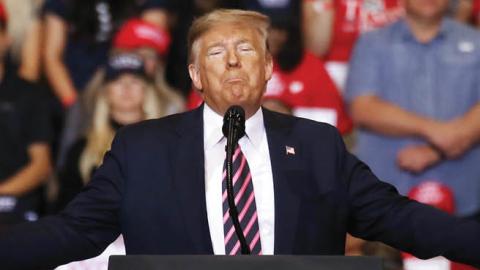INTRODUCTION
Towards the end of the previous decade, the term “Trump Derangement Syndrome” (TDS) became part of common parlance in American opinion pages. For supporters of Donald Trump, the term refers to a tendency by progressive elites and media organizations to view everything the President does as destructive to American leadership and institutions because these elites and organizations have never come to terms with the victory of Donald Trump over Hilary Clinton in the 2017 presidential elections. For detractors of the President, TDS represents an outrageous coinage by Trump’s supporters to deflect what are legitimate and serious charges against the President’s exercise of his powers.
The temptation to treat the Trump’s administration’s policies as being irretrievably tied to the character and whims of America’s historically most unconventional commander-in-chief is strong, the embedded implication being that a different President in the White House will lead to a very different suite of external policies.
INTRODUCTION Towards the end of the previous decade, the term “Trump Derangement Syndrome” (TDS) became part of common parlance in American opinion pages. For supporters of Donald Trump, the term refers to a tendency by progressive elites and media organizations to view everything the President does as destructive to American leadership and institutions because these elites and organizations have never come to terms with the victory of Donald Trump over Hilary Clinton in the 2017 presidential elections. For detractors of the President, TDS represents an outrageous coinage by Trump’s supporters to deflect what are legitimate and serious charges against the President’s exercise of his powers. The temptation to treat the Trump’s administration’s policies as being irretrievably tied to the character and whims of America’s historically most unconventional commander-in-chief is strong, the embedded implication being that a different President in the White House will lead to a very different suite of external policies.
This article does not attempt to predict specific policies that a second-term Trump administration or a first-term Democrat one will pursue. Specific policies are mostly shaped by empirical events and by the responses of senior individuals in the administration. Especially in the case of a possible Democrat White House, it is impossible to know these factors ahead of time.
It is a more useful and feasible exercise to draw out what is unique to President Trump and his administration, and what mindsets and approaches will be different if there is a Democrat White House in 2021—as these pertain to the FOIP, Quad and general Southeast Asian policy.
__Bear in mind that the key to understanding American policy in the future under Trump or else a Democrat president, is China.__ The change in the US over the past few years has been remarkable. The author has been associated with the Hudson Institute in Washington, DC since the first decade of this century when George W. Bush was in power. Until recently, threats and challenges such as Russia, the Middle East and terrorism competed with the growing competition with China for attention and resources.
That balance has shifted dramatically. Perhaps the greatest mistake of Xi Jinping’s more assertive and seemingly more confident foreign policy approach over the past few years has been in waking up a slumbering and somewhat complacent American giant. Except for specific threats such as North Korea’s illegal nuclear and missile programmes, the Trump administration’s focus on the region is largely about China— about balancing and countering Beijing’s policies and actions, to be more specific.
The point is that the key to American regional policy, including the FOIP and Quad and as these relate to Southeast Asia, will predominantly be driven by its China policy. This is not to deny that America has important bilateral relationships with countries such as the Philippines and Singapore. But its China policy will remain the determining and decisive factor regardless of what happens in the November 2020 elections for the White House.
This article looks at the profound and enduring shifts in mindset and perspectives vis-à-vis China that have been adopted and championed by the Trump administration, and which are broadly supported by the Democratic Party and its policy community. These mindsets and perspectives inform the operationalization of the Free and Open IndoPacific and approaches to groupings such as the Quad.
The article then looks at aspects of continuity and change which would occur if a Democrat were to occupy the White House from 2021 onward.
Read the full article in ISEAS



















